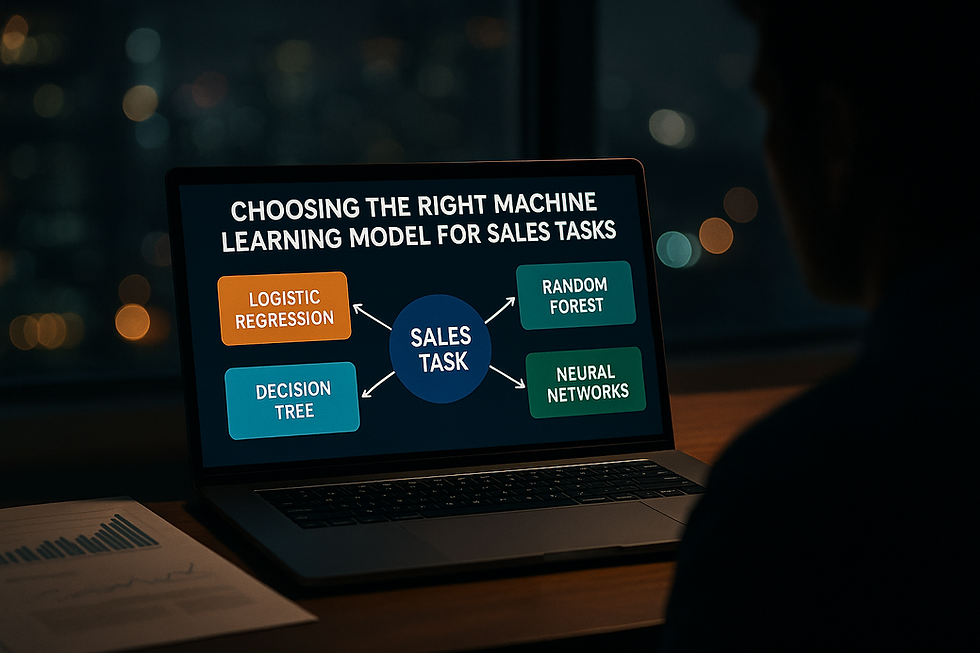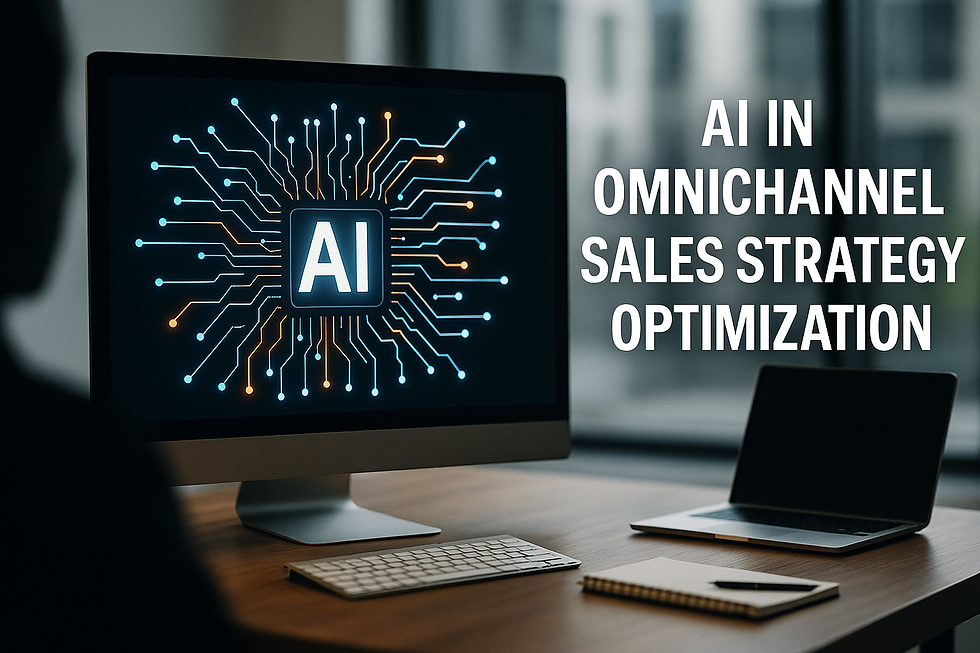Why Sales Teams Must Embrace Machine Learning
- Muiz As-Siddeeqi

- Aug 20
- 5 min read

Why Sales Teams Must Embrace Machine Learning
They’re Not Waiting for You Anymore
The truth hurts.
But here it is: buyers have changed. Drastically. Permanently. And they’re not waiting for your sales team to catch up.
By the time a buyer speaks to your rep, they’re already 70% through the decision-making process. That’s not a guess — it’s data from Forrester Research [source: Forrester B2B Buyer Study].
What does that mean for your team? It means intuition, experience, and even charm aren’t enough anymore. Not by a long shot.
Sales is no longer about who makes the best pitch — it’s about who makes the smartest moves, powered by the smartest tech.
This blog isn’t about pushing shiny AI tools or hyping up futuristic fantasies. This is a call to arms — built on real data, real stories, real companies — showing why machine learning (ML) is no longer a “nice to have” for your sales team…
…it’s your survival kit.
Bonus: Machine Learning in Sales: The Ultimate Guide to Transforming Revenue with Real-Time Intelligence
The Invisible Shift: How the Sales Game Changed Behind Your Back
You didn’t see it happen.
No one did. Not really.
Because it wasn’t a massive announcement or a loud explosion. It was quiet, slow, invisible — like software updates running in the background. But while your team stuck to CRMs and cold calls, your competitors trained ML models to do what no human could:
Identify the hottest leads from thousands of data points
Predict which accounts would churn — before the customer even realized it
Customize sales scripts, timing, and pitches down to the individual decision-maker
And we’re not talking theory. McKinsey reported that companies using ML in sales saw up to a 50% increase in leads and appointments, and a 40–60% reduction in call time [Source: McKinsey & Company, “The secret to making it in the new world of sales”].
Wake-Up Call: The Sales Giants Already Using ML
You know what’s not fun? Losing deals to people who didn’t work harder than you — they just worked smarter.
And that’s exactly what’s happening.
Here’s just a small taste of how some of the world’s most documented sales teams are already winning with machine learning:
1. Lenovo — Predicting Buyer Intent with Laser Accuracy
Lenovo, the tech giant, wanted to revamp its sales pipeline. Instead of relying on rep intuition, they used machine learning algorithms trained on 1.3 million data points across industries, geographies, and behaviors. Result?
11% increase in conversion rates
Targeting accuracy improved by 50%
Sales productivity increased across 3 continents
[Source: IBM Case Study on Lenovo Sales Optimization with Watson AI]
2. HubSpot — Smart Lead Scoring That Saves Time
HubSpot implemented ML-based lead scoring using historical customer data. They didn’t just rely on forms or survey responses. Their ML engine processed behavioral patterns, email interactions, website activity, and more.
The outcome?
Automated prioritization of high-potential leads
Sales reps reduced wasted time on cold prospects
Increased average deal velocity by 35%
[Source: HubSpot AI Lead Scoring Report]
3. Gartner Prediction: By 2026, 65% of B2B sales organizations will transition from intuition-based selling to data-driven selling using ML, AI, and automation.
That’s less than 12 months from now.
[Source: Gartner Report “The Future of Sales”]
Let’s Talk Real Numbers: Sales KPIs Transformed by Machine Learning
ML doesn’t just “assist” sales — it transforms the scoreboard. Here's what documented organizations report after integrating ML:
Metric | Without ML | With ML | Source |
Lead-to-Close Rate | ~5-10% | 20-25% | Salesforce AI Impact Study |
Churn Detection Accuracy | ~50% | 90%+ | Gainsight Case Study |
Time Spent on Admin Tasks | 30-40% of rep time | Reduced by 80% | Accenture Sales Automation Report |
Forecast Accuracy | ±25% error | ±5% error | InsideSales AI Forecasting Whitepaper |
The Pain of Sticking to Old Habits
We’ve seen companies hemorrhage revenue because they refused to change.
One U.S.-based SaaS company, valued at $200M, stuck with manual sales processes while its competitors embraced ML.
Within 18 months:
Their deal conversion dropped by 17%
High-churn customers went undetected
Their top 3 enterprise clients moved to a competitor using ML-enhanced personalization
The company? Pardot. And the competitor? Marketo, who had just integrated Adobe’s ML-based customer behavior engine.
[Source: MartechSeries and Adobe Sales AI Integration Analysis]
What Sales Tasks Can Machine Learning Actually Handle?
You don’t need to replace your team.
You just need to give them superpowers.
Machine learning enhances — not replaces — your reps. Here’s how ML is handling the dirty work in documented, real-world settings:
Lead Scoring — Ranking leads based on behavioral and firmographic signals (used by Salesforce Einstein, HubSpot AI, Zoho Zia)
Churn Prediction — Alerting reps before key clients start ghosting (used by Gainsight, Totango)
Email Timing Optimization — Sending emails when the recipient is most likely to open them (used by Outreach.io, Mailchimp ML)
Pricing Recommendations — Suggesting discounts or bundles based on buyer profile (used by PROS, Salesforce CPQ)
Sales Forecasting — Predicting revenue down to rep-level accuracy (used by Clari, Anaplan)
Objection Busted: “Our Reps Know the Customer Best”
We get it.
There’s pride in knowing your customer. Years of experience. Gut instincts. And those shouldn’t be thrown away.
But let’s be brutally real: data doesn't lie.
And today, your customer’s behavior is spread across hundreds of invisible signals — browser cookies, time-on-page, competitor comparisons, skipped webinar replays — signals no human could possibly track, analyze, and make sense of in real-time.
Machine learning can. And does.
In fact, companies that combine human reps with ML-driven suggestions close 23% more deals on average, according to a 2024 LinkedIn Sales Insights Study.
So this isn’t about replacing your rep. It’s about replacing guesswork.
What Happens If You Don’t Embrace ML?
Let’s not sugarcoat this:
You will lose market share
Your best reps will burn out doing tasks ML could handle
Your forecasts will be wrong more often than right
Your customers will leave — silently, invisibly, predictably
And worst of all?
You’ll realize too late that the companies who did adopt ML didn’t just survive… they redefined the entire game.
How to Start (Without Hiring Data Scientists)
Think it’s too late to start? Think you need PhDs in machine learning?
You don’t.
Here’s what companies are doing right now, without building in-house ML models:
Using CRM platforms with ML built-in
Salesforce, HubSpot, Zoho — all have embedded ML capabilities. You just need to turn them on and learn how to interpret their suggestions.
Connecting ML APIs like OpenAI, DataRobot, or H2O.ai
These plug into your systems, analyze your sales data, and start surfacing actionable insights — no internal dev needed.
Training sales teams to work with AI tools
Enable your reps to understand and trust ML insights. Gartner found that sales orgs that train reps to interpret ML suggestions close 31% more high-ticket deals.
Final Words: This Is Not About Hype — It’s About Survival
We’re not AI evangelists.
We’re not data scientists selling a dream.
We’re sales operators who’ve seen teams win massively with ML… and teams get crushed because they ignored it.
And we want this to be very, very clear:
Embracing machine learning in sales is not optional anymore.
It’s not about being innovative. It’s about staying relevant.
If you wait 6 more months, your competitors won’t just be ahead — they’ll be too far ahead to catch.

$50
Product Title
Product Details goes here with the simple product description and more information can be seen by clicking the see more button. Product Details goes here with the simple product description and more information can be seen by clicking the see more button

$50
Product Title
Product Details goes here with the simple product description and more information can be seen by clicking the see more button. Product Details goes here with the simple product description and more information can be seen by clicking the see more button.

$50
Product Title
Product Details goes here with the simple product description and more information can be seen by clicking the see more button. Product Details goes here with the simple product description and more information can be seen by clicking the see more button.






Comments